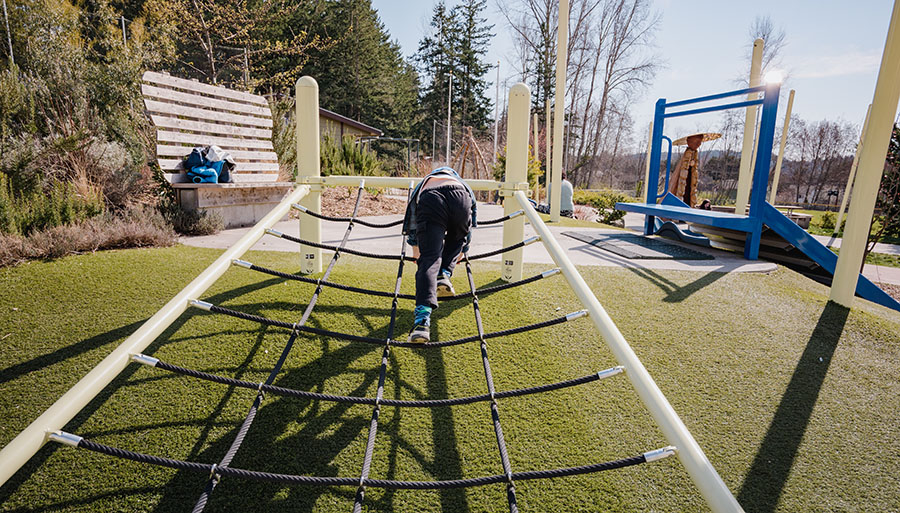Just the facts—and the FAQs.
We get asked this all the time. The skeptics want to know. And so do our well-meaning supporters who are concerned that low-income buyers won’t profit, as they might have, from the American dream of homeownership.
Owning a community land trust home most definitely does not keep people poor. Rather, it creates the housing stability needed to nurture family, career, health, and wellbeing. And it creates an opportunity to build wealth too. Read on to see how community land trust homes best serve Bainbridge Island’s need for affordable housing.
How do community land trusts work?
HRB is a community land trust. Community land trusts keep home prices low by separating the value of the home from the value of the land. HRB sells the home and retains ownership of the land, which it leases to the homeowner for a 99-year term with the option to renew. We oversee each original sale and every resale thereafter to ensure that homes are sold to other income-qualified households at a price that is affordable.
How do community land trust homes stay affordable?
Regulations in the ground lease—not market forces—dictate the sale price, balancing affordability for the buyer with equity for the seller. HRB homeowners earn a maximum 1.5% annual rate of return.
Does community land trust homeownership keep people poor?
The one we’ve all been waiting for…
While it is true that community land trust homeowners cannot sell at market rate and therefore won’t make the outsize profit so many associate with real estate, they earn equity by paying down the mortgage principal (instead of a landlord) and ultimately, by selling at a price that reflects a small percentage of appreciation. Equally important, mortgage payments are fixed and often become increasingly manageable, while rent can only go up.
In 2020, an HRB home, appraised at $604,500, sold for $185,107. The price was affordable to the buyer, and the seller built $62,000 in equity over seven years.
CLT homes are inheritable.
A $185,107 home on Bainbridge?!
That’s right. The homes at the HRB-designed Ferncliff Village were built on land donated by longtime Bainbridge residents, Lois and King Curtis. Construction of phase 1 (24 single-family homes) finished in 2014. Phase 2 (16 townhomes) finished in 2016. Certainly, free land and post-recession timing helped with affordability. But so does the passage of time. The 31 homes that HRB will acquire at Wintergreen Townhomes to be built off High School Road near Walgreens will have a base price of $369,000. Sure, that’s considerably more than $185,107. But check back in ten years. Housing prices will continue on their rapid rise, and that $369k is going to look even more affordable then than it does today.
Why are community land trusts a sustainable model for affordable housing?
Community land trust homes make maximum use of land and funding, and they align housing prices with wages.
Here’s what happens when there are no resale restrictions, as is the case with many other models of affordable housing:
- The individual homeowner sells at market rate, which on Bainbridge might mean considerable profit, maybe even enough to buy a home on the open market. One household benefits from the initial public and private subsidy that went into creating the affordable home.
- The community loses an affordable home. If it is to continue to create a place for people whose work and life circumstances make buying a market-rate home impossible, more land and funding must be found to build a replacement.
With their resale restrictions, community land trust homes continue to give back to the community, serving generations of low-income families to come.
Is allowing homeowners to sell on the open market a bad idea?
Not at all. Community land trusts prioritize the current and future needs of the whole community. But there are strong arguments in favor of the individual wealth-building model, especially when one considers the effects of structural racism. For example, Black people have had 90% of their land taken from them, violently and illegally, since the turn of the 20th century and suffer a continuing legacy of housing discrimination. In this light, the individual wealth-building model can be a way to right these historic and present-day wrongs.
But it’s unlikely to be the best model for Bainbridge, where land is at a premium and where many residents seek to balance their affordable housing and conservation goals.
What does homeownership not mean to HRB?
A commodity.
What does homeownership mean to HRB?
A safe and affordable place to live. Housing stability. A strong and healthy Bainbridge Island.
